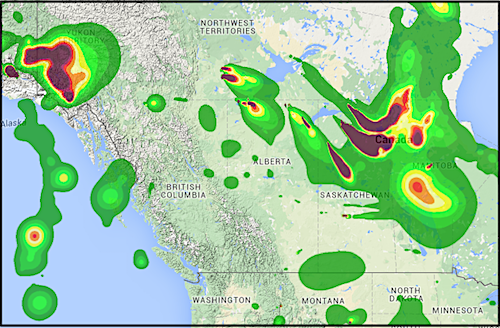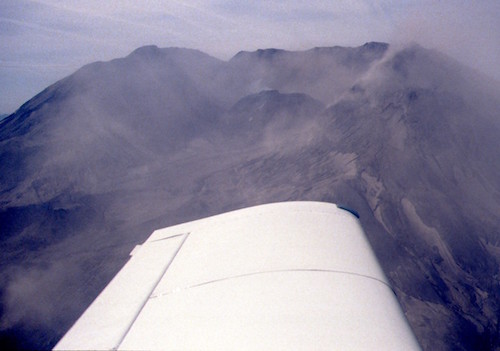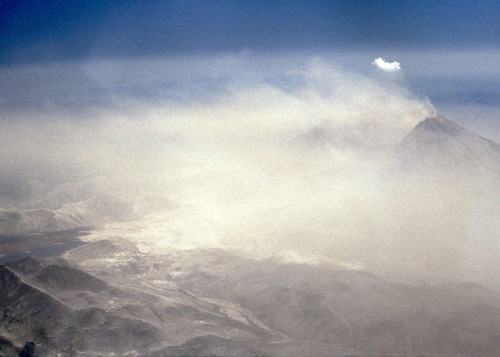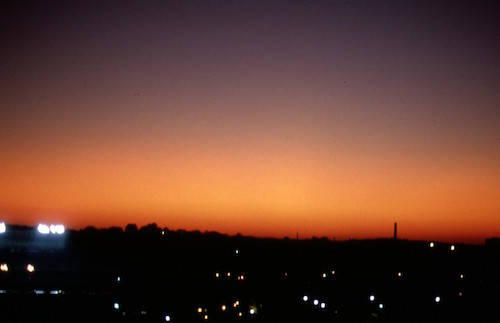ATSC 113 Weather for Sailing, Flying & Snow Sports
Obscurations
Learning Goal 1i. Explain the nature of these obscurations: haze, smoke, blowing dust/sand, blowing snow, volcanic ash, rain, and how they affect aviation.
Pilots flying visually (VFR, see Learning Goal 1g) must see where they are going. Sometimes the sky is obscured, meaning that something is totally or partially blocking your view of either the sky or the ground. A pilot trying to take off might not have good enough visibility (see Learning Goal 1e) to depart safely, and an aircraft approaching an airport might not be able to see the runway to land safely. For these reasons, pilots check to see if there are any current or forecast obscurations before they fly.
Obscurations (and their abbreviations)
include: mist [BR; horizontal
visibilities ≥ 1 km (i.e. ≥ 5/8 of a statute mile)], fog
[FG; visibilities < 1 km (i.e. < 5/8 statute mile)], smoke (FU), volcanic
ash (VA), sand (SA), haze (HZ), spray
(PY), and widespread dust (DU). Snow
and blowing snow causes many hazards, one of which is as an
obscuration. Fog is discussed in detail in Learning
Goal 1h. Visibility is also reduced in rain, which can
obscure landmarks needed for VFR flight.
Mist
Mist is when very small precipitation particles (small rain drops, only slightly larger than 0.5 mm) are gently falling through the air. Visibility is usually greater than 1 km (about 5/8 mile), as compared to fog, which has lower visibilities. Mist can exist in air having a relative humidity between 95% and 100%. (Relative humidity is the ratio of actual water vapor in the air to the maximum water vapour possible in the air, expressed as a percentage.) Mist creates a thin grey-colored partial obscuration.
Smoke
Smoke can come from factories, cars, and forest fires. The figure below shows smoke from the Fort McMurray, AB, forest fire in 2016.
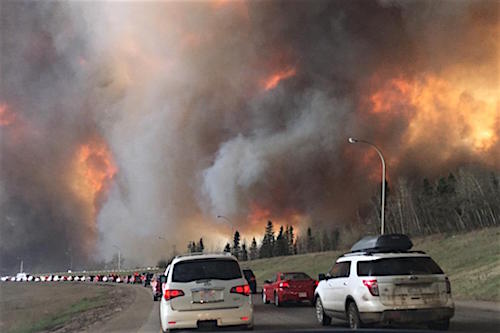
© User:DarrenRD / Wikimedia Commons / CC BY-SA 4.
Even far downwind of forest fires and other wild fires, the smoke is often spread out somewhat uniformly within the bottom several km of the atmosphere. In the photo below, the smoke is so thick that it is difficult to see the bottom parts of the clouds.
My research team makes forecasts of forest fire smoke for the public, as sponsored by the Environment Ministries in the provinces of BC, AB, SK, and ON, and with former federal support from the CSSP program. Here is an example from 20 July 2016, from the firesmoke.ca web site.
Smoke from forest fires and other sources can reduce visibility to
the point where it is a hazard to aviation. Also, if you
fly through smoke then you could breathe the toxic fumes that enter the
aircraft cockpit or cabin through the aircraft ventillation system.
Volcanic Ash
Ash from a volcanic eruption is not like the soft, fluffy ashes from a fireplace. Instead, volcanic ash consists of microscopic rocks with sharp edges. The smallest ash particles are so small that they settle out very slowly due to gravity. But while they are suspended in the air, they can cause serious problems to aircraft that accidently fly through the ash clouds.
Volcanic ash is very abrasive, like sandpaper. If it gets in an aircraft internal combustion engine, it can cause bearings and gears to wear-out very quickly and fail or seize (stop turning). It can clog or contaminate the air filter, the oil filter, and the aircraft and passenger ventillation systems. It can sandblast the windscreen, making it difficult to see through. If it sticks to wings and other surfaces, it adds weight and changes the balance of the aircraft. Also, as ash hits the aircraft, it causes a static electric charge to build up, which at night can be seen as St. Elmo's fire (sparks writhing across the windscreen). And, as an obscuration, ash clouds reduce your visibility.
If volcanic ash gets in jet/turbine engines, it can not only abrade the turbine components, but can also melt and re-solidify into glass-like coatings and protuberances that cause the turbines to break. Two Boeing 747 aircraft lost power on all four engines when they accidently encountered volcanic ash.
For this reason, volcanic ash forecast maps are produced for aviation. But they are produced only when the hazard exists.
The Mount St. Helens volcano in the Washington Cascade Mountains, USA, erupted on 18 May 2008. I flew past it later that summer. By that time, ash was mostly being emitted by the volcano into lower levels of the atmosphere, so I could safely fly over most of it. See photos below.Volcanoes also emit lots of gases, such as sulfur dioxide, high into the stratosphere. This gas gradually reacts to become small sulfate particles that are blown completely around the world many times by the winds in the upper atmosphere. These very tiny particles, called aerosols, are not a hazard to aviation — though they do cause amazingly beautiful red skies long after the sun has set below the horizon!
Sand
Strong winds over deserts and sandy regions can create sand storms, also called haboobs. Some of these haboobs are created by outflow winds from thunderstorms (Learning Goal 4b).
Most of this sand falls out of the atmosphere fairly quickly after the winds subside. However, the finer sand particles can stay suspended for hours after the wind has decreased. The sand storms have a similar abrasive effect on aircraft and engines as does volcanic ash (but perhaps not melting in jet engines). The sand storms also greatly reduce visibilities and create large static electric charges, making flying and using navigation instruments difficult — so don't fly into haboobs.
Sadly, even if your aircraft is tied down on the ground, the strong winds associated with a haboob can sandblast your aircraft. That is why many aircraft owners in parts of the world where sandstorms are frequent will always park their planes in hangars.
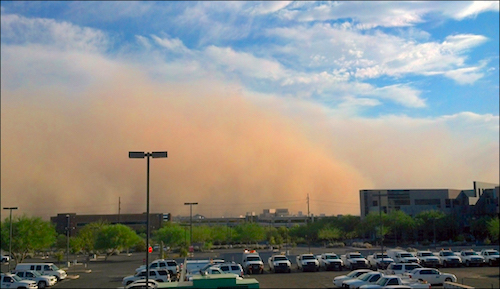
Courtesy of the US National Weather Service.
Here are some nice photos from the US National Weather Service with safety recommendations:
- https://www.weather.gov/safety/wind-dust-storm
- https://www.noaa.gov/stories/haboobs-phenomena-with-unusual-name-is-no-joke
- https://www.weather.gov/abq/northamericanmonsoon-windsdust
Here are some amazing YouTube videos of sandstorms:
- https://www.youtube.com/watch?v=iC2qlU8G8vw
- https://www.youtube.com/watch?v=3glyRZLZAR0 (play this one at 5x speed)
- https://www.youtube.com/watch?v=RD5I9UhbRgg
See the American Meteorological Society Glossary for the definition of a haboob: http://glossary.ametsoc.org/wiki/Haboob
Haze
Haze is weird. It consists of microscopic liquid water droplets that form around a pollutant particle or chemical that attracts water vapor. Because of this attractive (hygroscopic) behavior, the haze particles can grow even when the relative humidity in the air is less than 100%, sometimes as low as 75%. (Normally, clean liquid water drops form when the relative humidity is at 100%, i.e. when the air is holding all the water vapor that it can at that temperature.)
Another weird aspect is that haze particles quickly grow to a final small size by attracting water vapor out of the air, but they don't keep growing. They stop growing at a particular microscopic size (radii of about 0.0001 mm) determined by the humidity, temperature, and the particular hygroscopic chemical. (Normally, larger liquid water drops keep growing as long as there is excess water vapor to condense onto them.)
Small haze particles are generically known as aerosols, which include microscopic solid and liquid particles. The original pollutant particles might be very small and spread out in the air, so that visibility is good (i.e. not haze). However, as the humidity increases above about 75%, these particles suddenly become larger (called aerosol swelling) as they soak up water vapor, resulting in the aerosol particles that reduce visibility. The reduced visibility is a flight hazard.
Examples of common hygroscopic chemicals are salt (e.g. left in the air after sea spray evaporates), sulfates (a pollutant associated with oil and coal burning, with volcanic emissions, and with farts from small microscopic phytoplankton in the sea), nitrates (a pollutant by-product of combustion), and quite a few biological (organic) chemicals emitted from plants while they live, burn, or decay.
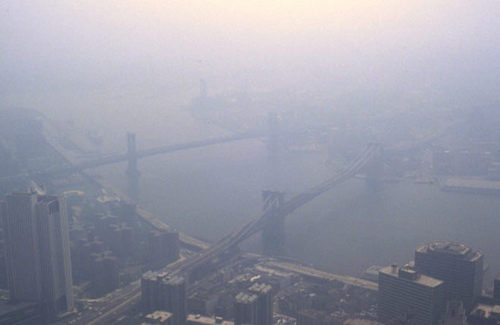
Haze (smog) in New York City. Public domain, courtesy of the U.S. Centers for Disease Control and Prevention (CDC), Public Health Image Library (ID# 1523).
Spray
Breaking waves cause tiny droplets of sea water to be injected into the atmosphere. These small droplets (less than about 0.2 mm in diameter) settle out very slowly. You can often see the effects of spray near a beach during windy conditions with breaking waves — the visibility is very poor due to the spray. When spray exists, it is usually relative close to the ground.
I have encountered poor visibilities due to spray when landing at airports adjacent to ocean beaches. Notice the white layer near the horizon on the second photo below, caused initially by sea spray. The salt in the sea-spray attracts water from the air, which continues to create a white haze even as the wind blows that air away from the beach.
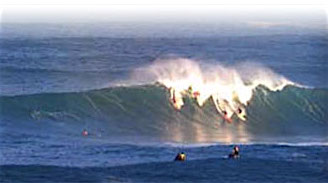
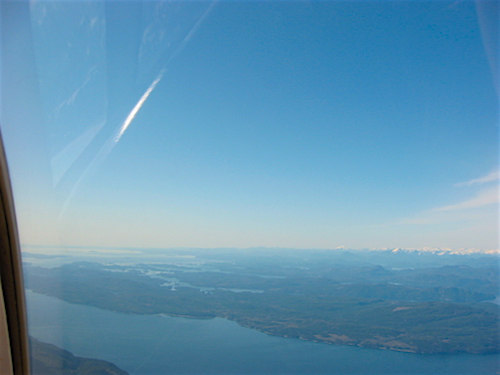
Left: Photo courtesy of National Marine Sanctuaries, US NOAA. Right: Photo by R. Stull while flying over the Georgia Strait, BC, Canada.
Here is a nice YouTube video showing sea spray from wave breaking: https://www.youtube.com/watch?v=xvNNTc6ZPtQ (watch only a minute or two. Can you see rainbows in the spray above the breaking waves?)
Dust
Dust in the atmosphere can consist of a variety of microscopic solid substances (dirt, pollen, ashes, decaying biological material) stirred up into the atmosphere from the Earth's surface. These dust particles are smaller than the sand particles of sand storms. Hence, the dust can stay in the air longer after the strong winds end, because the particles gravitationally settle out more slowly.
During droughts, when strong winds blow over normally arable farmland, the fine particles in the soil can be lifted by the turbulent winds and temporarily suspended in the atmosphere as a dust storm. Examples are the dust bowl conditions in the central USA in the 1930s. In severe duststorms the visibility can be reduced to values less than 1/4 mile (about 400 m), making it a hazard to aviation.
See the American Meteorological Society Glossary for a definition of a dust storm: http://glossary.ametsoc.org/wiki/Duststorm
Dust storms are similar to the sand storms described earlier, except
that the dust particles are smaller size than sand particles.
Often, the general public (and TV news people) use "dust storm" and
"sand storm" interchangeably.
Snow and Blowing Snow
The intensity of snowfall is often evaluated based on the visibility
through snow. For example, heavy
snow has visibility less than 0.4 km (0.25 miles), while moderate
snow
has visibility in the range 0.4 to 0.8 km (0.25 - 0.5 miles).
Although snow is listed as a weather element (in present or past
weather), it does affect visiblity and can obscure landmarks important for air
navigation and landing.
A blizzard is when there is blowing snow in the air with reduced visiblity (less than or equal to 0.25 miles in USA, or 1 km in Canada) AND fast wind speeds (greater than or equal to 35 miles/hour in USA, or 40 km/hour in Canada). In extreme conditions, visibility can be so poor that pilots and observers report a "white out", where you cannot discriminate between the ground and sky because everything is white and visibility is low. Even after a snowfall as ended, fast winds can pick up snow from the ground to create poor visibility. White out is also discussed in the Snow-sports Weather theme.
Rain
Light and moderate rain can have reduced, but
acceptable, visibilities. But heavy rain can be a problem (see
figure below). Although
not officially listed as an obscuration, heavy rain can
reduce visibility to the point where landmarks and obstacles (e.g.,
mountains, tall towers, wind turbines, etc.) are obscured, preventing
safe VFR flight.
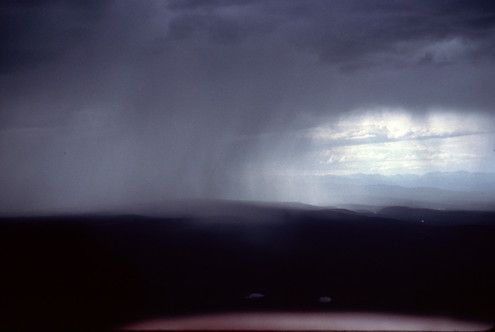
Luckily, heavy rain often has limited horizontal extent. Namely,
it is patchy. Thus, pilots can often fly around the heavy rain
regions to remain in conditions safe for VFR flight.
Obscuration Symbols
Recall from learning goal 1f the weather-map symbols for these obscurations:
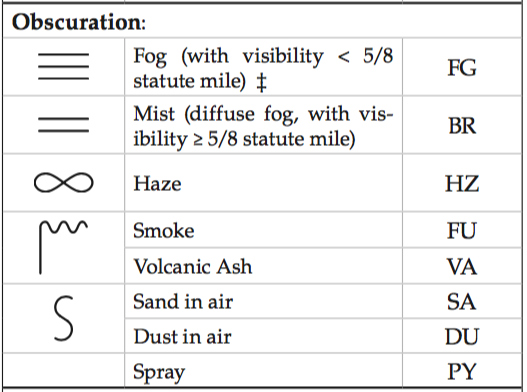
The abbreviations in the right column above are used in textual weather reports called METARS.
The weather-map symbol for heavy snow is: 
and for blowing snow is:

Key words: aerosol swelling, aerosols, dust, dust
storm, fog, haboob, hygroscopic, haze, mist, nitrates, obscured,
organic, salt, sand, sand storm, smoke, spray, sulfates, VFR, volcanic
ash, visibility, St. Elmo's fire, blowing snow, blizzard, white out,
heavy snow, moderate snow.
Extra info for Experts; Not Needed for this Course.
- US FAA AC 00-6B - Aviation Weather (2016), Chapter 16. Weather, Obstructions to Visibility, etc.
- An excellent user's guide: Aviation Weather Services, Advisory Circular, AC 00-45H —available for free as a PDF. 331 pages. It is updated every several years or so; (14 Nov 2016) is valid at the time of this writing. See section 3.1.3.8.5 for obscurations.
Every US pilot should get a copy, because it explains how to interpret text products (METARs, PIREPs, TAFs, FAs, etc.), graphics products (including analysis and forecast charts, radar and satellite images), aviation hazards products (SIGMETs, AIRMETs, tropical cyclone and volcanic ash advisories, SIGWXs, icing and turbulence potential), and much more. You can also buy printed copies of this advisory from online retailers.
- World Meteorological Organization (WMO) Cloud Atlas, section on Lithometeors .
- Federal Meteorological Handbook, Number 1. Surface Weather Observations and Reports, (30 Nov 2017) Section 8.3.2 & 8.5.2 Obscurations
- Volcanic ash: TC AIM (2018 or most recent) MET 2.5 and 1.3 and Table 8.1, and AIR 2.6 .
- FAA-AIM, (13 Sep 2018) section 7-1-27, PIREPs Relating to Volcanic Ash Activity (PDF page 486)
Image credits. All figures by Roland Stull, except where otherwise indicated.

